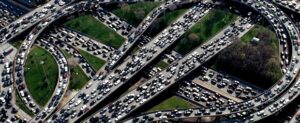 Typical traffic on the Grand Central Parkway/Van Wyck Expressway interchange.
Typical traffic on the Grand Central Parkway/Van Wyck Expressway interchange.By Dave DeFusco
New York City traffic jams tend to begin with clusters of tie-ups within a network of streets before expanding rapidly and chaotically to surrounding areas, according to a paper published by two professors in the Katz School’s M.A. in Physics.
In the paper, “Cascading Traffic Jamming in a Two-Dimensional Motter and Lai Model,” published in Physical Review E in August, Professors Gabriel Cwilich and Sergey Buldryev found that a group of “nodes,” or an intersection of several streets or roads, became congested, or failed, in a small circle and then expanded quickly in various directions.
To study the phenomenon, Cwilich and Buldryev used the Motter and Lai model of cascading failures, which are catastrophic processes that can destroy the functionality of a system, including electric power grids, communications networks and traffic patterns.
“We’ve been looking particularly at processes of overload,” said Cwilich. “We used this idea of overload to mimic traffic in the city. Simply put, if too many cars arrive at an intersection, it gets blocked and people try to go somewhere else. Then suddenly you have an expansion of blockages, or gridlock.”
The initial size of the traffic “failure”—number of intersections blocked—determines how it propagates. If the size of the initial blockage is very small, traffic manages to normalize and the congestion remains localized in a small region. But if it is large, traffic congestion keeps expanding to affect a large part of the city.
“This research may lead to a better management of everyday complex infrastructure,” said Cwilich. “Strategies to protect systems against failure are what we’re interested in. If you can protect against failure in a few critical places as opposed to all of them, that can be done much cheaper and efficiently.”
Cascading failures are common in most complex networks. They take place on the internet, where traffic is rerouted to bypass malfunctioning routers unequipped to handle extra traffic. Most failures emerge and evaporate locally, largely unnoticed. A few, however, percolate through dense technological and social networks, hitting users from the most unexpected directions.
During blackouts, a cascading failure occurs when power lines become overburdened through a surge of electricity, and the grid that distributes the electricity malfunctions in a short period of time. The magnitude of a blackout is rooted in an often-ignored aspect of a globalized world: vulnerability due to interconnectivity.
Cwilich and Buldryev are also concentrating on what happens when failures occur at 10 intersections, for example, up and down a road, in a line, from a central point.
“We are currently exploring the influence of the shape of the initial failure,” said Cwilich. “An elongated initial failure results in more devastating consequences than a circular one of the same size, but this isn’t an area that has been fully explored.”
